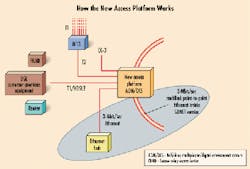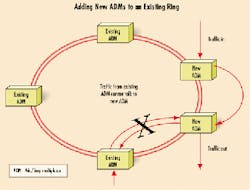The metro-access bottleneck: How will new architectures help?
New metro-access platforms will offer more bandwidth, multilayer processing, and a wide range of services.
Scott Lukes
MAYAN Networks
Time to face the facts-the honeymoon is over. After record investments in new service providers and the unprecedented rebirth of the incumbents' business models, the market expects results. It's time to get back to the basics and turn all of those newly minted business plans into real net profit-easier said than done, however.
Consider the market. Metro and long-haul core networks have experienced dramatic improvements in bandwidth efficiency with the advent of technologies such as wavelength-division multiplexing (WDM) and dense WDM (DWDM). Today's fiber core technology can deliver in excess of 1 petabit/sec over a single optical cable. Yet, despite this dramatic increase in carrying capacity at the core of the network, most Internet users still access the network over slow analog modems. Small businesses are constrained to connections no faster than 1.5 Mbits/sec. The bottleneck to network access and growth is not at the core but at the edge of the network.
Because of the sheer size of the market, a large amount of funding has been committed to startups whose mission is to address the metro network edge. This trend represents a huge opportunity for carriers, especially competitive local-exchange carriers (CLECs), to offer bundled services based on time-division multiplexing (TDM), Internet protocol (IP), and Asynchronous Transfer Mode (ATM) directly to customers. In many cases, the CLECs will be able to offer these services faster and more economically than the incumbents.
But service providers must face the reality that the low-hanging fruit of standard data and voice has already been picked. The battle for low-cost voice and digital-subscriber-line (DSL) services has been raging for some time, lowering costs and margins. Competitive service providers must therefore reach for the next layer of fruit on the tree. That means targeting smaller customers in multi-tenant high-rises and office parks. Here, the traffic mix is more heterogeneous in nature and not as predictable. The challenge is to come up with new ways to address multiple types of traffic with innovative bundled service offerings.
The selection and deployment of the new access technologies required to offer multiple services presents other issues. To meet today's demands, service providers must be able to terminate, switch, and route a vast array of traffic types and services. Today, this approach requires the purchase of optical access equipment such as add/drop multiplexers (ADMs) and digital access and crossconnect systems (DACs), in addition to Layer 2 and Layer 3 switching and routing equipment. The price tag of this equipment is high, as is the cost to install, manage, and maintain it.
These high costs present a formidable barrier to CLECs with cash-flow constraints. New technology is needed that provides low-cost optical access and consolidates the functionality of five to seven of these network edge components.
The Synchronous Optical Network (SONET) protocol-Synchronous Digital Hierarchy (SDH) outside the United States-is, and will continue to be, the de facto standard for metropolitan networks for some time. Last year, more than 90% of all interoffice LEC traffic was carried over SONET transport facilities, according to market research from Pioneer Consulting (Cambridge, MA). SONET is widely accepted because it is standardized and provides exceptional reliability to its users.
While there are many advantages to using traditional SONET, there are some drawbacks, as well. From its inception, SONET was optimized to carry voice over relatively rigid TDM channels. These channels are quite inflexible when it comes to bandwidth allocation, especially when dealing with data. SONET was also only incorporated in Layer 1 products such as ADMs and crossconnects. Due to these equipment restrictions, any switching or processing occurring at Layer 2 and above must be done with other devices such as routers, ATM switches, or frame-relay switches.
The ADMs acting as on/off ramps to the traditional SONET ring don't scale well to higher speeds. Thus, if a service provider has an existing SONET network using OC-48 (2.5 Gbits/sec) and wishes to upgrade to OC-192 (10 Gbits/sec), then typically, the carrier must replace the existing ADMs.
During the first half of 1999, startups in the optical space rushed forth with a whole spectrum of new solutions to address these SONET shortcomings. These solutions fall into four categories:
- WDM and DWDM solutions.
- Multiservice access platforms.
- Next-generation SONET transport platforms.
- Switches and routers that handle both data and voice traffic.
While each solution type made progress toward network simplification and cost improvements, each also has its shortcomings for the metro edge. WDM/DWDM technology only makes sense for metro core and interoffice applications. Multiservice access platforms help aggregate traffic, but most of these platforms do not interoperate with existing SONET equipment. Initial offerings in enhanced SONET transport platforms were more optimized for central-office (CO) and metro-core applications, and most of the improvements for switches and routers tended to focus on voice-over-IP (VoIP) applications in the enterprise space.
Advances in off-the-shelf semiconductor and optical technology are giving startup vendors an advantage not enjoyed by the early entrants. A new generation of packet and cell access platforms is due to hit the street in the second half of this year. The basic premise for these products is simple: Make more efficient use of the existing SONET infrastructure (e.g., next-generation SONET transport), while at the same time supporting many physical and logical interfaces (multiservice access). Thus, a single device will allow service providers to combine many existing elements in the access network. Some vendors are even integrating edge switching and routing functionality (Layers 2 and 3 processing), which will allow service providers to offer customers multiple service types at a price point that is a fraction of what they would have to pay with existing technology.
While the premise is simple, these cutting-edge devices, in and of themselves, are not. For example, to offer customers in a high-rise building a local-area-network (LAN) service over Ethernet, the access device must be able to perform Layer 3 routing and support multiple routing protocols such as border gateway protocol (BGP), open shortest path first (OSPF), and routing interchange protocol (RIP). If the customer desires LAN service over DSL, the access platform must essentially perform the functions of a DSL access multiplexer (DSLAM) at Layers 1 and 2, including ATM/frame-relay interworking functions to support virtual private networks (VPNs). Another customer might need to concentrate DS-1s (1.544 Mbits/sec) into a DS-3 (44.736 Mbits/sec) for transport to a corporate headquarters; hence, the access device must have the functionality of an M13. Moreover, to access the service provider's SONET ring, the device must perform the functions of an ADM and perhaps a digital-crossconnect switch. This heterogeneous mix of traffic types, protocols, and multilayer processing requires a very advanced architecture optimized for the metro edge.
While most of these next-generation access devices are designed to aggregate multiple traffic types at the metro edge and efficiently consolidate it on SONET carriers, the reality is that no two access platforms are alike. Many architectural distinctions differentiate these offerings; a few key issues deserve special attention.
For example, flexibility with regard to the traffic mix and layer processing is critical. Service providers need to support a multitude of physical interfaces (Ethernet, T1/T3, DSL, etc.) and process a broad spectrum of protocols (ATM, frame relay, IP, TDM, etc.). Architectures that permit the de-coupling of the physical interfaces from the protocol processing engines allow customers to migrate from simple voice and data services to more advanced ATM and IP services within minutes-versus weeks. In addition, architectures that provide traditional Layer 1 functions (circuit switching, multiplexing) and support Layer 2 and Layer 3 features (cell- and packet-based switching and routing) allow the customer to gracefully migrate from basic to more advanced services such as ATM and frame-relay VPNs or packet over SONET.
The granularity with which the architecture can aggregate traffic is also important. An ADM with an output speed of OC-12 (622 Mbits/sec) traditionally accepts inputs of no less than DS-3. Likewise, an OC-3 (155-Mbit/sec) device typically accepts inputs of no less than DS-1. That is a problem for service providers wishing to offer low-speed services at the network edge without wasting bandwidth.
In a traditional architecture, a 3-Mbit/sec data stream would have to be converted to a DS-3 at 45 Mbits/sec in order to be fed into the SONET ADM. The SONET ADM would then reserve an entire OC-3 stream at 51.8 Mbits/sec to accommodate the DS-3. This approach yields a significant amount of wasted bandwidth. By bundling VT1.5s together using multilink point-to-point protocol, a few of these access devices are able to allocate the exact amount of bandwidth necessary on the SONET ring, significantly increasing bandwidth utilization. At a minimum, the service provider will want to efficiently aggregate and switch inputs down to DS-1 (if not DS-0) on an OC-12 SONET loop.
Efficient traffic grooming allows a 3-Mbit/sec data stream to occupy 3 Mbits of SONET bandwidth (see Figure 1).Figure 1. New access platforms incorporate the functionality of multiple network elements. The shaded area demonstrates how, using these devices, a 3-Mbit/sec Ethernet stream is mapped onto 3 Mbits/sec of the SONET carrier, conserving previously wasted bandwidth.
Scalability is another issue to consider when comparing the new access architectures; that, of course, also relates to cost. Service providers trying to capture business in a high-rise or office park must enter the market with a minimal capital outlay. After addressing basic voice and data services with a cost-effective entry platform, service providers want to be able to offer higher-end services (and thus equipment) as the customer base increases. This capability involves an architecture that distributes processing power across multiple modules, or cards, so that the entry platform is cost-effective but scales in performance as modules or cards are added. Scalability is also required when service providers deploy the same platform in various locations around a SONET ring-CO, colocation, Internet service provider, high-rise-each location may need a different level of performance and range of services.
Figure 2. Some new metro-access add/drop multiplexers (ADMs) may not interoperate with ADMs in the existing SONET infrastructure.
Paradoxically, most of the emerging ATM virtual-path (VP) solutions that eliminate the TDM "granularity problem" can actually aggravate it by having this interoperability limitation. To coexist with the existing SONET infrastructure, these VP ADMs will reserve an STS-3 worth of bandwidth on a larger ring. These devices will then proceed to efficiently package data and voice within the reserved STS-3, but when the traffic overflows, the STS-3, the VP ADMs jump to an STS-12. When that happens, a single DS-0 of overflow will require 455 Mbits/sec to transport.
Service providers face serious challenges as they strive to expand their offerings to include multiple service types amid increasing competition and decreasing margins. By utilizing their existing SONET infrastructures in conjunction with next-generation cell- and packet-based optical platforms, carriers can cost-effectively offer flexible and scalable services to customers.
Evaluating solutions to the metro-access bottleneck is no easy task due to a lack of available information and the wide variety of offerings. In the end, the access platforms that provide the highest degree of flexibility and scalability at a price point that lowers barriers-to-entry for service providers will succeed. As with anything in the free market, service providers should be judicious in their selection of a next-generation metro-access platform since not all access platforms are created equal.
Scott Lukes is the market development manager at optical-networking startup MAYAN Networks (Sunnyvale, CA).


